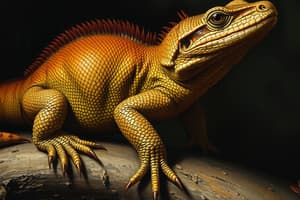Podcast
Questions and Answers
What is the Kingdom Classification for reptiles?
What is the Kingdom Classification for reptiles?
Animalia
What is the Phylum Classification for reptiles?
What is the Phylum Classification for reptiles?
Chordata
What is the Subphylum Classification for reptiles?
What is the Subphylum Classification for reptiles?
Vertebrata
What is the Class Classification for reptiles?
What is the Class Classification for reptiles?
What is the Order Classification for Caiman?
What is the Order Classification for Caiman?
What is the Order Classification for Copperhead?
What is the Order Classification for Copperhead?
What is the Order Classification for Gecko?
What is the Order Classification for Gecko?
What is the Order Classification for Terrapin?
What is the Order Classification for Terrapin?
What is the Order Classification for Skink?
What is the Order Classification for Skink?
What is the Order Classification for Tuatara?
What is the Order Classification for Tuatara?
What is the Order Classification for Gavial?
What is the Order Classification for Gavial?
What is the Order Classification for Anaconda?
What is the Order Classification for Anaconda?
What is the Order Classification for Leatherback?
What is the Order Classification for Leatherback?
What is the Order Classification for Iguana?
What is the Order Classification for Iguana?
What is the Order Classification for Gila Monster?
What is the Order Classification for Gila Monster?
What is Allantois?
What is Allantois?
What is Yolk?
What is Yolk?
What is Albumen?
What is Albumen?
What is Amnion?
What is Amnion?
What is Chorion?
What is Chorion?
Why are reptiles classified as a paraphyletic group?
Why are reptiles classified as a paraphyletic group?
List three ways in which the skeleton of a reptile differs from the skeletons of other vertebrates.
List three ways in which the skeleton of a reptile differs from the skeletons of other vertebrates.
What is an Anapsid?
What is an Anapsid?
What is a Synapsid?
What is a Synapsid?
What is a Diapsid?
What is a Diapsid?
What is the information for Turtles?
What is the information for Turtles?
What is the information for Tortoises?
What is the information for Tortoises?
What is the description of a Crocodile?
What is the description of a Crocodile?
What is the description of Gavials?
What is the description of Gavials?
What is the description of an Alligator?
What is the description of an Alligator?
What is the description of a Caiman?
What is the description of a Caiman?
List four ways Tuataras are different from most other reptile species.
List four ways Tuataras are different from most other reptile species.
What are Jacobsons?
What are Jacobsons?
What part of the reptile brain is enlarged and controls muscle movement and interprets sensory information?
What part of the reptile brain is enlarged and controls muscle movement and interprets sensory information?
What era is nicknamed the Age of Reptiles?
What era is nicknamed the Age of Reptiles?
Where are tuataras found?
Where are tuataras found?
What structure helps reptiles rip through the shell to hatch out of their eggs?
What structure helps reptiles rip through the shell to hatch out of their eggs?
What is the largest turtle species?
What is the largest turtle species?
How many chambers do most reptiles have in their hearts?
How many chambers do most reptiles have in their hearts?
What type of venom do Copperheads use to attack the nervous system of their prey?
What type of venom do Copperheads use to attack the nervous system of their prey?
What are Hemipenes?
What are Hemipenes?
What type of egg do reptiles lay?
What type of egg do reptiles lay?
What is the dorsal surface of a turtle called?
What is the dorsal surface of a turtle called?
Flashcards are hidden until you start studying
Study Notes
Reptile Classification
- Kingdom: Animalia
- Phylum: Chordata
- Subphylum: Vertebrata
- Class: Reptilia
- Orders include Crocodilia (e.g., Caiman, Gavial, Alligator) and Squamata (e.g., Copperhead, Gecko, Anaconda, Skink, Iguana, Gila Monster), along with Testudines (Turtles and Terrapins) and Rhynchocephalia (Tuatara).
Reptile Orders and Examples
- Crocodilia: Caiman, Gavial, Alligator
- Squamata: Copperhead, Gecko, Anaconda, Skink, Iguana, Gila Monster
- Testudines (Chelonia): Terrapin, Leatherback
- Rhynchocephalia (Sphenodonta): Tuatara
Amniotic Egg Structures
- Allantois: Membrane storing metabolic wastes of the embryo
- Yolk: Fat-rich food supply for the embryo
- Albumen: Contains water and protein, supports embryo
- Amnion: Encloses fluid for embryo protection
- Chorion: Outermost membrane protecting the other membranes
Reptile Evolution and Anatomy
- Paraphyletic group, excluding some descendants of the most recent common ancestor.
- Unique skeletal features: one ear bone, one occipital condyle, distinct skull shape.
- Types of skulls: Anapsid (no openings, e.g., turtles), Synapsid (one opening, found in mammals), Diapsid (two openings, found in most reptiles excluding turtles).
Turtle and Tortoise Adaptations
- Turtles: Streamlined, disk-shaped shells; adapted for aquatic environments with webbed feet or flippers.
- Tortoises: Dome-shaped shells; land-dwelling with adaptations like stout legs for burrowing.
Specific Reptilian Characteristics
- Crocodiles: Triangular heads with visible teeth, found in Africa, Asia, and South Florida.
- Gavials: Long, slender snouts, males have a distinctive knob.
- Alligators: Wide heads, round noses, predominantly found in China and the Southern US.
- Caimans: Similar to alligators with shorter snouts, located in Central and South America.
Tuataras
- Unique adaptations: active in cooler temperatures, possess a median parietal eye, slow growth, lengthy egg incubation (up to 1.25 years).
- Native to New Zealand.
Sensory and Brain Functions
- Jacobsons: Pit-like organs in snakes' mouths aiding in smell.
- Cerebrum: Enlarged part of the brain controlling movement and sensory processing.
Historic Context
- The Mesozoic Era is known as the "Age of Reptiles."
Reptilian Reproductive Features
- Reptiles typically lay amniotic eggs, featuring a structure (tooth) that assists embryos in breaking out of their shells.
- Most reptiles possess a heart with three chambers.
- Unique reproductive anatomy includes hemipenes, allowing double copulation.
Venom and Feeding
- Copperhead snakes utilize neurotoxic venom affecting prey's nervous system.
Turtle Anatomy
- The dorsal surface of a turtle is referred to as the carapace.
- The largest turtle species is the leatherback.
Studying That Suits You
Use AI to generate personalized quizzes and flashcards to suit your learning preferences.




